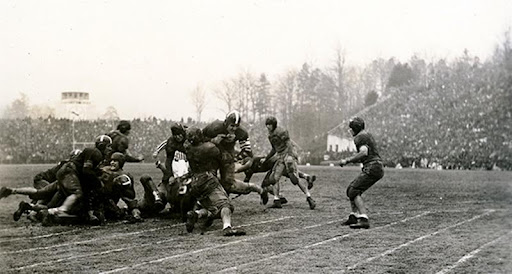The following represents the opinion of the student reporter and does not represent the views of Loyola University Maryland, the Greyhound, or Loyola University’s Department of Communication.
Almost 45 million viewers watched as Damar Hamlin of the Buffalo Bills was given CPR following a collision with Bengals receiver Tee Higgins during a Monday Night Football primetime game. The collision appeared to be a routine tackle; however, after standing up and taking a few steps, Hamlin collapsed. Hamlin reportedly suffered cardiac arrest and needed to be administered resuscitation on the field. He was immediately taken to Cincinnati Medical Center and listed in critical condition. After serious debate from NFL executives and outcry from both teams as well as the fans, the game was indefinitely postponed.
Kiersten Morrisroe ‘23, a viewer of the game, said, “When [Hamlin] first collapsed on the field, I thought he was just injured. It was really terrifying when I found out his heart stopped and saw all the players crying. I was just hoping he wouldn’t die in front of us.”
The public has shown great support for Damar and his recovery, donating over $8 million to his Chasing M’s foundation.
This injury, while severe, is not a common injury in the sport of football. Cardiac arrest as a result of contact is extremely rare for young, healthy athletes. In contrast, head injuries are often less spectacular in their suffering but can be much more devastating.
The long-term effects of repeated head trauma are not fully known. One of the most common afflictions is chronic traumatic encephalopathy. CTE is a degenerative brain disease that has been linked to repetitive brain trauma, such as concussions. It has been found in the brains of many former NFL players, as well as other athletes who have suffered multiple concussions. The symptoms of CTE can include memory loss, mood swings, depression, and dementia.
Jac DeLuise, a Doctor of Physical Therapy and certified strength and conditioning specialist for Towson Sports Medicine, said that repeated head injuries could have negative effects on the mental demands of afflicted athletes, including mood regulation disorders. DeLuise advocates for the increased popularity of flag football over the dangers associated with competitive football. She said that the best ways to reduce the likelihood of a concussion are technological improvements as well as increased training.
“[The new technology] in helmets they have now helps a ton, as well as the proper training on how to hit and pretest measurements to establish a baseline measurement,” DeLuise said.
Tua Tagovailoa, a quarterback for the Miami Dolphins, is a notable example of a player who has recently suffered numerous concussions. Most noteworthy was a tackle that involved his helmet striking the turf field. Upon his return to his feet, he was seen on live television stumbling his way to the huddle, seemingly unaware of his surroundings. He briefly left the game but returned following halftime. Very few coaches, fans, or officials took the hit as seriously as seemed to be required. Some fans even created memes or jokes surrounding this solemn medical incident.
Sean Kerwin ‘23, an avid football fan who witnessed the event, said, “The hit was pretty gruesome, but they never said anything about how bad it was on the broadcast. We thought he was fine; they said it was a back injury.”
The NFL was originally slow to take action about head injuries. For years, the evidence became abundant that football caused higher levels of neurodegenerative diseases, such as Parkinson’s or Alzheimer’s. Congress released a 91-page report in 2018 that found the NFL guilty of attempting to divert $16 million in funding away from head injury research. In addition, the National Football League Players’ Concussion Injury Litigation, which included 4,000 plaintiffs, settled a lawsuit with the NFL for over $765 million in 2013. The NFL opted to settle the lawsuit, which alleged that the league hid evidence regarding brain trauma, out of court.
Bennet Omalu, a Nigerian-American scientist, worked feverishly to spread information to the public about football-related head injuries. This controversy was famously depicted in the 2015 movie, “Concussion.” Since this forced outing by the media, the NFL has attempted to change the narrative surrounding head injuries. They have raised awareness and created initiatives to help limit the devastating effects of these injuries. However, these initiatives are not enough.
Numerous players have committed suicide, developed life-threatening injuries, and suffered debilitating neurological diseases as a result of the insufficient measures promoted by the NFL. Most notably, Junior Seau, a former NFL star, committed suicide as a result of brain-related debilitation.
In brief, the NFL only cares about interferences with their cash flow. Thus far, the head injury epidemic that is plaguing the sport of football has not interfered with their business model. It is reported that 70% of NFL fans believe that head injuries have no effect on their interest in the game. As the number of concussions per season grows, this statistic must change. Without strong support and serious concern from fans, the NFL will continue to inadequately protect its players. Will these notable and highly publicized concussions polarize the fans in a similar manner to Damar Hamlin?
For more information about head injuries and the NFL, check out this video.
Featured Image Courtesy of Duke University Archives, Creative Commons 3.0 License







































































































